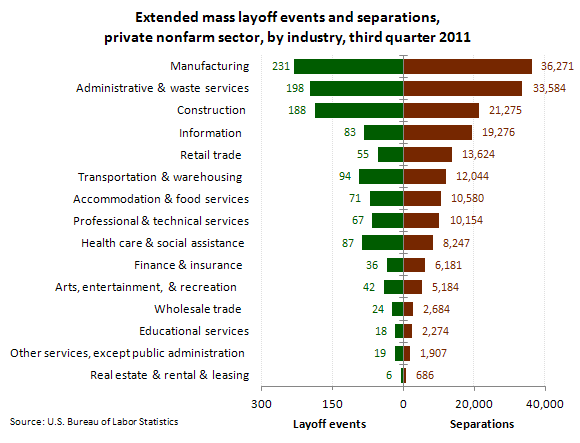November 16, 2011 (The Editor’s Desk is updated each business day.)
Extended mass layoff events and separations, third quarter 2011
Manufacturing firms had 231 extended mass layoff events that resulted in the separation of 36,271 workers from their jobs for at least 31 days. Both events and separations in the manufacturing sector were at series' lows in the third quarter of 2011. Eight of the 21 manufacturing subsectors experienced over-the-year decreases in the number of layoff events.

[Chart data]
Administrative and waste service firms had 198 extended mass layoff events and 33,584 separations, primarily due to contract completion.
In the third quarter of 2011, total extended mass layoff events decreased over the year from 1,370 to 1,226, and associated worker separations fell from 222,357 to 184,493. Events and separations reached their lowest third quarter levels since 2007. Both events and separations have decreased over the year for eight consecutive quarters.
The number of extended mass layoff events declined over the year in 13 of the 18 major private nonfarm industry sectors. The transportation and warehousing and the accommodation and food services sectors experienced the largest declines in the numbers of worker separations over the year.
These data are from the Mass Layoff Statistics program. Extended mass layoff data for the most recent quarter are preliminary and are subject to revision. For more information, see "Extended Mass Layoffs — Third Quarter 2011" (HTML) (PDF), news release USDL-11-1611. The quarterly series on extended mass layoffs cover layoffs of at least 31-days duration that involve 50 or more individuals from a single employer filing initial claims for unemployment insurance during a consecutive 5-week period.
Related TED articles
Labor force |
Manufacturing |
Unemployment
Of interest
Spotlight on Statistics: National Hispanic Heritage Month
In this Spotlight, we take a look at the Hispanic labor force—including labor force participation, employment and unemployment, educational attainment, geographic location, country of birth, earnings, consumer expenditures, time use, workplace injuries, and employment projections.
.
Read more »
